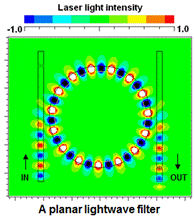Student training: Students are immersed within a fully integrated research and teaching environment. Investigations span concept development, design, modeling, simulation, fabrication, test, and measurement. Students learn a host of modeling and simulation techniques including the finite difference time domain method, the finite element method, and the beam propagation method. In the clean room, students are involved completely hands-on to learn state-of-the-art nanophotonic fabrication techniques in-house at Ohio State University. Technologies involve electron beam lithography, thin film deposition, plasma etching, and electron beam microscopy. Students learn to work with lasers, photodetectors, and high-frequency analog/digital electronics in the integrated optics characterization lab. Students present their research at international conferences and publish their results in OSA, IEEE, SPIE, and AVS journals.
Coursework: Prof. Reano is the curriculum advisor for Electro-Optics and Photonics in the Department of Electrical and Computer Engineering. Courses taught by Prof. Reano include:
ECE 5012 (Integrated Optics): This course teaches the fundamentals of planar lightwave circuits and guided wave devices. Topics include: wave propagation in optical waveguides; coupled mode theory; electro-optic and nonlinear optical effects; design and synthesis of modulators, filters, couplers, resonators, switches, and multiplexers; numerical methods.
ECE 6511 (Nonlinear Optics): This course involves nonlinear optics for the generation, propagation, amplification, and control of laser light. Topics include: nonlinear polarization of material media; harmonic, sum, and difference frequency generation; parametric amplification and oscillation; intensity dependent index of refraction; four wave mixing; Raman scattering; all-optical switching and solitons; wavelength conversion and phase conjugation.
ECE 3010 (Introduction to RF and Optical Engineering): This is the core undergraduate course in electrodynamics. Topics include: Waves on transmission lines; charges, fields, and potentials; capacitance and inductance; Maxwell’s equations; Faraday’s Law; plane wave propagation; polarization; reflection and transmission.
ECE 3050 (Signals and Systems): This is a core undergraduate course focusing on discrete time and continuous time signals and transformations; Linear time invariant systems; Fourier series; Fourier transforms; Laplace transforms; Z-transforms.
Short course on Nonlinear Integrated Photonics: This is a half-day short course designed for researchers and practicing engineers in industry. The short course introduces the fundamentals of nonlinear optics in planar optical waveguides designed to exploit fundamental nonlinear optical effects including second harmonic generation, sum frequency generation, difference frequency generation, and the electro-optic effect. Applications in sensing, communications, and RF photonics are discussed in an experimental context involving waveguides composed of thin films of semiconductors, ferroelectrics, and polymers.
Networking: Students in the integrated optics laboratory are involved in the student chapter of the Optical Society of America (OSA). The chapter provides leadership experience and year-round networking opportunities for students with an interest in optics and photonics. OSA is an international scientific society dedicated to promoting the generation, application, and archiving of knowledge in optics and photonics, and disseminating this knowledge worldwide.




